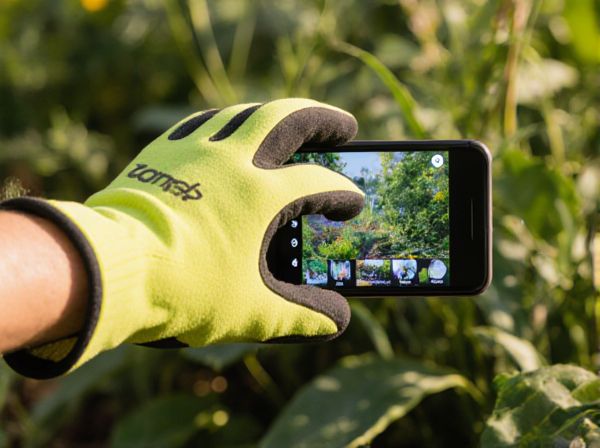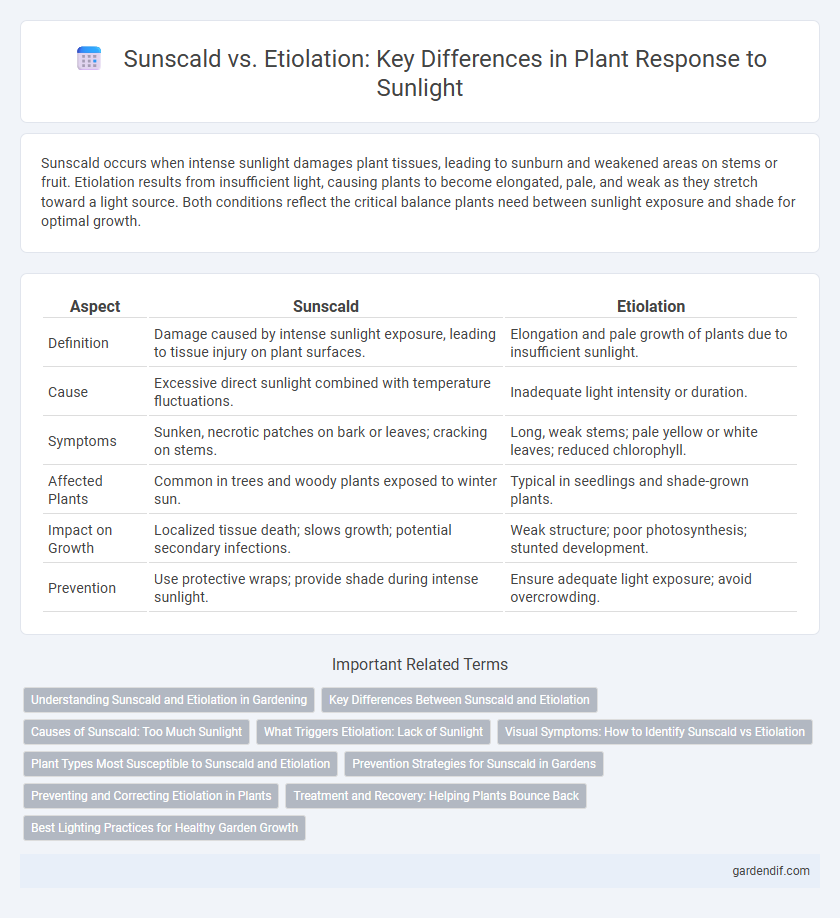
Sunscald vs etiolation Illustration
Sunscald occurs when intense sunlight damages plant tissues, leading to sunburn and weakened areas on stems or fruit. Etiolation results from insufficient light, causing plants to become elongated, pale, and weak as they stretch toward a light source. Both conditions reflect the critical balance plants need between sunlight exposure and shade for optimal growth.
Table of Comparison
| Aspect | Sunscald | Etiolation |
|---|---|---|
| Definition | Damage caused by intense sunlight exposure, leading to tissue injury on plant surfaces. | Elongation and pale growth of plants due to insufficient sunlight. |
| Cause | Excessive direct sunlight combined with temperature fluctuations. | Inadequate light intensity or duration. |
| Symptoms | Sunken, necrotic patches on bark or leaves; cracking on stems. | Long, weak stems; pale yellow or white leaves; reduced chlorophyll. |
| Affected Plants | Common in trees and woody plants exposed to winter sun. | Typical in seedlings and shade-grown plants. |
| Impact on Growth | Localized tissue death; slows growth; potential secondary infections. | Weak structure; poor photosynthesis; stunted development. |
| Prevention | Use protective wraps; provide shade during intense sunlight. | Ensure adequate light exposure; avoid overcrowding. |
Understanding Sunscald and Etiolation in Gardening
Sunscald results from intense, direct sunlight damaging plant tissues, causing discolored, sunken patches primarily on tree bark and fruit. Etiolation occurs when plants grow in insufficient light, leading to elongated stems, pale leaves, and weak structure due to excess cell elongation and chlorophyll loss. Recognizing the difference helps gardeners adjust light exposure to prevent sunscald's tissue damage and etiolation's stunted photosynthesis, promoting healthier plant development.
Key Differences Between Sunscald and Etiolation
Sunscald occurs when intense sunlight causes injury to plant tissues, typically resulting in sunken, discolored patches on bark or leaves, while etiolation is a growth adaptation to insufficient light characterized by elongated stems and pale, yellowish leaves. Sunscald damage manifests as physical burns or necrosis on exposed surfaces, whereas etiolation affects the plant's morphology due to inadequate chlorophyll production. Understanding these differences is crucial for diagnosing light-related stress and implementing appropriate plant care strategies.
Causes of Sunscald: Too Much Sunlight
Sunscald occurs when plant tissues are exposed to excessive direct sunlight, causing damage to the bark or leaves due to intense heat and UV radiation. This condition often affects young or thin-barked plants lacking adequate protective layers or acclimation to full sun exposure. Excessive sunlight disrupts cellular function, leading to sunburn, cell death, and increased vulnerability to pests and diseases.
What Triggers Etiolation: Lack of Sunlight
Etiolation is triggered by insufficient sunlight, causing plants to grow longer stems, pale leaves, and reduced chlorophyll production as they stretch towards light sources. This adaptive response helps plants maximize light capture in shaded environments but results in weaker, less healthy growth. In contrast, sunscald is caused by excessive sunlight exposure, leading to tissue damage on plant surfaces rather than elongated growth.
Visual Symptoms: How to Identify Sunscald vs Etiolation
Sunscald appears as localized, sunken, and discolored patches on plant stems or fruits, often with cracked, blistered bark caused by intense direct sunlight. Etiolation is characterized by elongated, pale-yellow stems and smaller, underdeveloped leaves due to inadequate light exposure. Visual identification relies on the presence of sun damage and tissue necrosis in sunscald versus overall stretching and pale coloration in etiolation.
Plant Types Most Susceptible to Sunscald and Etiolation
Woody plants such as fruit trees and shrubs are most susceptible to sunscald due to their bark's sensitivity to sudden temperature fluctuations caused by intense sunlight. Etiolation primarily affects shade-loving and young seedlings of herbaceous plants, which elongate excessively and develop pale leaves when deprived of adequate light. Understanding these plant types' vulnerabilities helps gardeners implement targeted protection strategies against sunscald and etiolation.
Prevention Strategies for Sunscald in Gardens
Sunscald prevention in gardens involves providing shade during the hottest parts of the day and using protective wraps on tree trunks to reduce bark damage caused by intense sunlight. Applying mulch around the base of plants helps maintain soil moisture and temperature, reducing stress that can increase vulnerability to sunscald. Selecting sun-resistant plant varieties and gradually acclimating seedlings to full sun exposure minimizes the risk of damage compared to etiolation caused by insufficient light.
Preventing and Correcting Etiolation in Plants
Preventing etiolation in plants requires providing adequate sunlight exposure, ideally 6 to 8 hours of direct light daily to promote healthy, compact growth and prevent pale, stretched stems. Correcting etiolation involves gradually increasing light intensity and duration while avoiding sudden exposure that can cause sunscald, which damages plant tissues. Using grow lights or relocating plants to brighter spots ensures sufficient photosynthesis and pigment development, reversing etiolation symptoms over time.
Treatment and Recovery: Helping Plants Bounce Back
Sunscald treatment involves gradually acclimating plants to sunlight by providing shade during peak hours and applying protective creams or wraps to damaged areas, while ensuring consistent watering to maintain plant hydration. Etiolation recovery requires relocating plants to adequate light sources, trimming elongated, weak stems, and promoting new, healthy growth through balanced fertilization and proper watering. Both conditions demand patience and careful monitoring to restore vitality and prevent further stress.
Best Lighting Practices for Healthy Garden Growth
Sunscald occurs when sudden exposure to intense sunlight damages plant tissues, while etiolation results from insufficient light causing elongated, weak growth. Maintaining moderate, consistent lighting through partial shading and gradual sun exposure prevents sunscald and supports robust photosynthesis, ensuring healthy garden development. Optimizing light quality and duration tailors conditions to specific plant species, enhancing overall vitality and growth balance.
Sunscald vs etiolation Infographic

 gardendif.com
gardendif.com